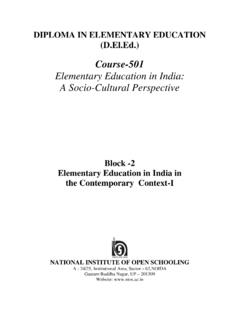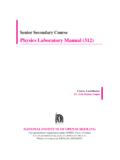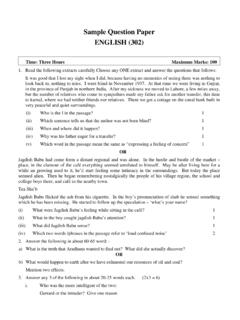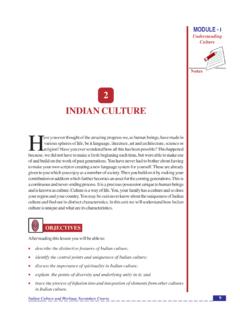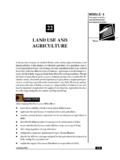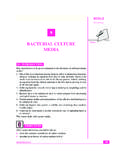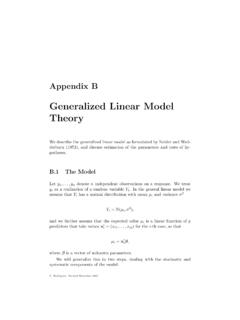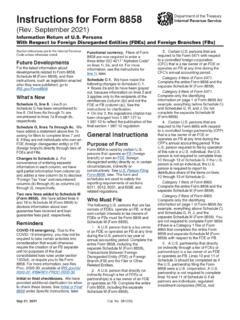Transcription of TYPES OF LIBRARIES AND INFORMA TION CENTRES
1 LIBRARY AND information SCIENCEMODULE - 1 LIBRARY, INFORMATIONAND SOCIETY 14 NotesTypes of LIBRARIES and information Centres2 TYPES OF LIBRARIES ANDINFORMATION INTRODUCTIONIn the previous lesson, you have learnt about the need, importance and functionsof a library in the society. You have read that LIBRARIES play an important rolein socio-economic, cultural and educational development of a society. Thelibraries strengthen literacy among the people. Library services improveknowledge and skills of people for positive productivity thereby contributingto national development.
2 There are many TYPES of LIBRARIES throughout the this lesson, you will learn about different TYPES of LIBRARIES and their functionsin the present day society. We will discuss each type of library along OBJECTIVESA fter studying this lesson, you will be able to: identify the type of a library, viz., Public, Academic, Special and National; explain the parameters (users, collections and services) for categorizing thelibraries; illustrate the objectives, functions and services of each type of library; list various levels of academic and public LIBRARIES ; and give examples of each type of TYPE OF LIBRARIESL ibraries can be categorised into the following four TYPES , Academic, Public,Special and National LIBRARIES .
3 The public LIBRARIES function with specialMODULE - 1 LIBRARY, INFORMATIONAND SOCIETY 15 LIBRARY AND information SCIENCEN otesTypes of LIBRARIES and information Centresreference to present day information society and serve general public. Academiclibraries are those that are part of the educational institutions, ranging fromprimary schools to universities. The special LIBRARIES are a natural outcome ofneed for information support to research and development, business, industry,etc. A national library acquires all documents of and about a nation under somelegal provision and represents publications of and about the whole TYPES of LIBRARIES emerged due to increase in number of users,enormous increase in information resources in all disciplines and demand fordifferent TYPES of services by the the subsequent sections, you will read more about the need, objectives.
4 Functions and services of each type of QUESTIONS the reasons for categorizing the are the different TYPES of LIBRARIES identified to meet the requirementsof users? PUBLIC LIBRARYA public library is a social institution. It plays a significant role in the welfareof a society. There are a number of factors responsible for the evolution of publiclibraries. These are: Peoples urge for knowledge Improvement of literacy level through self-education As an information dissemination centre Need for life- long learning centre To be Community s intellectual centre As a Recreation centre Advancements in science and technologyWith the developments in computer and communication technologies.
5 It ispossible for the public LIBRARIES to provide quick information through massmedia and Definition of a Public LibraryA public library is a non-profit library established for the use of the generalpublic and maintained chiefly by public funds. In other words, a public libraryis for the public, by the public and of the public. It provides service to everyLIBRARY AND information SCIENCEMODULE - 1 LIBRARY, INFORMATIONAND SOCIETY 16 NotesTypes of LIBRARIES and information Centrescitizen irrespective of one s birth, caste, colour, sex, social, economic andeducational standard without any cost.
6 LIBRARIES of all categories are generallyused for five purposes, , education, information , recreation, aestheticappreciation and research. For example, Academic LIBRARIES are primarily usedfor education and research. Special LIBRARIES are meant for information andresearch, but Public LIBRARIES are visited for all the five s Public Library ManifestoUNESCO formulated a Public Library Manifesto for member countries in 1949and revised it in 1972. Later, in 1994, it prepared the Public Library Manifestoin cooperation with the International Federation of Library Associations andInstitutions (IFLA).
7 This manifesto is widely accepted by all countries. Itprovides guidelines regarding objectives, activities and services of publiclibrary; its funding, legislation and networks; its operations and managementand implementation of the Manifesto. It has specified the missions of the publiclibrary. These are given of the Public LibraryThe following key missions that relate to information , literacy, education andculture should be at the core of public library and strengthening reading habits in children from an early age; both individual and self conducted education as well as formaleducation at all levels; opportunities for personal creative development; the imagination and creativity of children and young people.
8 Awareness of cultural heritage, appreciation of the arts, scientificachievements and innovations; access to cultural expressions of all performing arts; inter-cultural dialogue and favouring cultural diversity; the oral tradition; access for citizens to all sorts of community information ; adequate information services to local enterprises, associationsand interest groups; the development of information and computer literacy skills; and participating in literacy activities and programmes for allage groups, and initiating such activities, if necessary.
9 (Source: )MODULE - 1 LIBRARY, INFORMATIONAND SOCIETY 17 LIBRARY AND information SCIENCEN otesTypes of LIBRARIES and information CentresIn short, the UNESCO Public Library Manifesto suggests that a public libraryis expected to play its role mainly in three principal areas viz. information ,education and culture. It has to serve as a: centre for information ; centre for self-education; centre for culture; and centre for local cultural The Objectives and Functions of Public LibrariesAccording to S. R.
10 Ranganathan, the objectives and functions of a public libraryare as given )Help the life-long self-education of one and all;ii)Furnish up-to-date facts and information on all subjects to one and all;iii)Distribute in an unbiased and balanced way all recorded information tothe citizens to help them discharge their duties towards local, nationaland international affairs;iv)Convey new knowledge to the researchers as early as possible;v)Preserve the cultural heritage of the country;vi)Provide facility for fruitful utilization of leisure time; andvii)Work for the continued social well being of citizens as the in-charge ofall functions of the public LIBRARIES are, summarized below:Most of the countries have legislation for public library system and they areset up considering the organizational structure and geographical distribution toreach all the people, , in all states, districts and villages.

